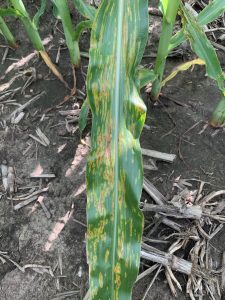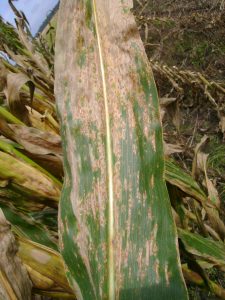The cooler temperatures and rains that have moved through the Northern part of Illinois the past 10-14 days have been favorable for the development of tar spot on corn. Although we have seen some elevated levels of this disease in the Northwest part of the state near Stark County,most fields have low disease levels. However, as I mentioned at Ag week, expect to see and hear more about the disease on corn over the next week as the pathogen starts to produce stroma on tissues that resulted from those rains 10-14 days ago. In a month the chatter will be even greater after this latest round of storms moved through today. 

What does this mean for corn in Illinois and potential management? First of all, we need to consider the crop growth stage. Many fields are approaching R5. After this point in time any sort of pathogen effect on yield will be nearly nonexistant. Some may argue that there could be a standability benefit with a late fungicide application. At R5 there isn’t much left as far as the life of the plant, so any benefit as far as keeping tissues free of disease and potentially limiting stalk rots will be minimal. In addition, this is an obligate pathogen, meaning that is needs a green host to grow and reproduce. When applying a fungicide at R5 you are not getting much benefit from managing disease and yields. In some fields, especially late planted fields, you may need to consider the effect of that fungicide on drydown and harvest date as well. I always encourage growers conduct their own experiments, so leave an untreated strip in your field to give yourself piece of mind- it doesn’t need to be enormous, simply large enough to run comparisons for yield and lodging potential. Of course, the most important thing to consider is your profitability, which is based off of the application cost, yield potential, and the protected yield. Go ahead and run the numbers using your personal experience with the hybrid in question, discounts, overall budget, the presence of other fungal diseases, etc.
Yield protected (bu/A) = application cost ($/A) / crop price ($/bu)
For example, you’d need to see at least 7 bushels protected to cover a $25 application cost at $3.50 per bushel. The likelihood of seeing that with an R5 application is low. For multiple applications realize that you are doubling the yield you need to make back to pay for the cost of application, and further reducing the probability for breaking even . In the aforementioned example that means you’d need to see at least a 14 bushel benefit if two fungicide applications are made.
Right now if you have tar spot showing up on your ear leaves or above I suggest going out and doing a standability check in 14 days or so. Go out to multiple points per field and test lodging potential for at least 20 plants at each site by pushing the plants 30 degrees from vertical at the ear. After testing at least 1 spot per 10-15 acres of field, determine the percent of lodged plants. If that number is greater than 10% you should consider harvesting that field as early as possible. In the future select hybrids with excellent staygreen characteristics and a good foliar disease package (GLS, NCLB) that scores well on university tarspot evaluation trials.
Remember- we are looking for Tar spot samples– send plastic bags of symptomatic leaves (corn and any grassy species), along with county information, nearest city, hybrid, and previous crop if known to Zach Duray- Tar Spot Survey: 1101 West Peabody Drive Room 63, Urbana, IL, 61801. Please do not send on a Friday.


